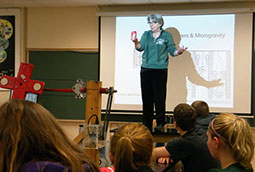By Gretchen Gregory
From Compass
Fifty-five Logan High School students from Autum Barry and Alyssa Burns’ biomedical science class and advanced placement biology class learned about plant biology and biomedical research at Ohio University during a recent visit to the Athens Campus.

Dr. Sarah Wyatt stands on a table to demonstrate the effects of a drop tower by pouring water from an aluminum can into a trash can below.
Photographer: Gretchen Gregory
Acid mine drainage mediation, photosynthesis and climate change, gravitropism, microgravity and genomics were some topics of discussion and afforded students an opportunity to learn more about each subject to find out if it sparked enough interest to start a career in a particular field.
“This experience gave students the opportunity to explore various science-related careers and to see real-world application of content and laboratory skills they have learned in the classroom,” Barry explained.
The trip was made possible by a Duke Energy grant through the Foundation for Appalachian Ohio and also included a visit to the OHIO Heritage College of Osteopathic Medicine.
Students asked a variety of questions related to the education and experience needed to pursue a career in plant biology, and intently listened as Environmental and Plant Biology Professor Dr. Morgan Vis, Assistant Professor Dr. David Rosenthal, Professor Dr. Sarah Wyatt, and Graduate Student Ben Gahagen led discussions about their latest research.
Wyatt was a first-generation college student who developed an interest in plants at a young age, she said, primarily because her parents were heavily involved in their farming community. Her interest in plants sparked an imagination that led her to seek a bachelor’s degree, master’s degree and doctoral degree and later conduct research with NASA.
“Think about all the science fiction movies you’ve ever seen,” Wyatt told a group of eager LHS students. “In every one of them and in every science fiction drawing, they always have a greenhouse. Somehow the science fiction authors have figured out that we’re going to have to take plants into space.”
Plants are taken on long-term space flights in order to understand how they grow within microgravity, she noted.
“When you’re doing a long-term space flight, how much stuff would it take for you to live for a year?” she asked the class. “All the food, all the water, and with all the stuff needed, the reason why you need to take plants—and why we need to understand how plants grow in modified gravity—is so we can take them along. They will provide us with medicines, food, clothing, and ultimately everything else we need, including air.”
Wyatt detailed that experiments can be tested in microgravity on Earth inside a KC135 airplane during parabolic flight in order to replicate the conditions in space.
“We get about 40 seconds of microgravity to test equipment,” she noted. “It’s really fun to be in microgravity.”
Wyatt’s research is trying to determine how bioregenerative life support in space might work and find the best mechanisms needed to support life. “We’re trying to figure out how we can best utilize plans in a small environment, and find out how we can best manage our plans and manage the ones we want to use and not completely destroy all the land,” she said.
Rosenthal told students about his work with photosynthesis and climate change and detailed how undergraduate students have a unique opportunity to participate in research at Ohio University.
“I really enjoyed speaking to the Logan High School students,” he said. “This was a unique opportunity to reach an audience I do not usually interact with. The sense I got from the students is that they were excited to be here.”



















Comments